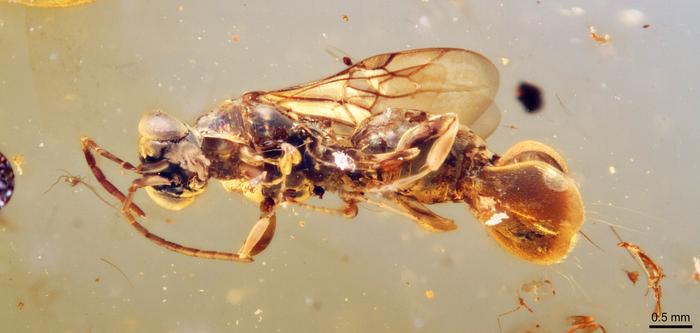
In a remarkable discovery that illuminates the complexity of ancient ecosystems, researchers have unveiled a new species of parasitic wasps that thrived during the mid-Cretaceous period, approximately 99 million years ago. This extinct lineage, recently christened Sirenobethylus charybdis, presents unique morphological adaptations that suggest it may have employed a Venus flytrap-like mechanism for capturing its prey. The implications of this finding are profound, offering fresh insights into the evolutionary mechanisms of parasitoids and their strategies for survival during a time when dinosaurs roamed the Earth.
Sirenobethylus charybdis is named after the Charybdis, a sea monster from Greek mythology, emphasizing the creature’s enigmatic nature. The species was identified through meticulously preserved specimens found in amber from the Kachin region of northern Myanmar, which has proven to be an extraordinary window into the past. These fossils provide not just visual specimens but also critical information regarding their biology, morphology, and the ecological dynamics in which these wasps existed.
The researchers, including experts from Capital Normal University in China and the Natural History Museum of Denmark, utilized advanced Micro-CT scanning technology to analyze a collection of sixteen female S. charybdis specimens. The intricate details revealed through this imaging method highlighted a striking abdominal structure formed by three distinct flaps. The lower flap, notably paddle-shaped and adorned with numerous hair-like bristles, bears an astonishing resemblance to the trapping mechanism of a Venus flytrap plant. Such a specialized adaptation raises questions about the predatory and parasitic behaviors of these ancient wasps.
The morphological features observed in S. charybdis strongly indicate that this species belonged to a unique clade of parasitoids, which are organisms that live on or in a host organism, often leading to the host’s eventual demise. Presently, the superfamily Chrysidoidea includes modern species like cuckoo wasps and bethylid wasps, but S. charybdis appears to belong to a lineage divergent enough to be classified into its own family, the Sirenobethylidae. This classification is based on the unique venation patterns found in the hind wings of the wasp, further emphasizing its distinct genetic lineage.
The concept of koinobiont parasitoids provides additional context for understanding S. charybdis. Unlike ectoparasitoids that typically kill their hosts, koinobionts allow their hosts to continue growing while consuming them internally. The researchers suggest that this wasp’s ability to wait patiently in an open position, while its trap mechanism was extended, allowed it to ambush mobile prey effectively. It is hypothesized that S. charybdis targeted small, agile insects that were common in their habitat, facilitating a successful predation strategy that highlights the adaptive radiation of insects during this era.
The evolutionary implications of the findings surrounding S. charybdis are significant. The existence of such a specialized mechanism during the mid-Cretaceous suggests that parasitoids may have exhibited a greater diversity of strategies than what is observed in contemporary insect families. The abundance and preservation of these fossils not only reveal individual characteristics of the species but also hint at the ecosystem dynamics and evolutionary pressures that shaped the interactions between predators and prey millions of years ago.
In conclusion, the discovery of Sirenobethylus charybdis is a pivotal contribution to the field of paleobiology, underscoring the intricate evolutionary story of parasitoid wasps. As researchers continue to unearth the mysteries encapsulated in amber, the understanding of ancient ecosystems will likely expand, providing new perspectives on the adaptive strategies that have influenced the trajectory of life on Earth. The findings serve as a reminder of the interconnectedness of species and the continuous interplay of evolutionary forces over eons.
The rich tapestry of ancient life is often woven with complex interactions between various organisms, and S. charybdis exemplifies how adaptations can lead to unique ecological niches. Future studies will undoubtedly delve deeper into the implications of its discovery, further illuminating the narrative of survival and evolution in prehistoric ecosystems.
The research on Sirenobethylus charybdis encourages a broader inquiry into the mechanisms of evolution and ecological dynamics, suggesting that every fossil holds a potential narrative waiting to be unraveled. By understanding the past, scientists not only gain insight into historical biodiversity but also inform contemporary biological studies, enriching our understanding of how life evolves under varying environmental pressures.
As studies like those on S. charybdis emerge, they highlight the need for continued exploration of paleontological resources. These findings are critical not just for academic knowledge but also resonate with the broader public interest, illuminating the often unseen connections between ancient organisms and modern biodiversity.
The successful identification of Sirenobethylus charybdis is a testament to the advancements in paleontological research methodologies, showcasing how modern technology can be applied to evolutionary studies. As researchers push the boundaries of what is known, each discovery adds another layer to the intricate story of life on Earth, beckoning future generations to explore and understand the vast array of life that once inhabited our planet.
Through meticulous research and innovative technology, the intricate relationships within ancient ecosystems are being restored, one fossil at a time. The story of Sirenobethylus charybdis is but one of many, yet it encapsulates the drama of survival, adaptation, and the never-ending quest for knowledge in the field of paleontology.
Subject of Research: Animals
Article Title: A Cretaceous fly trap? Remarkable abdominal modification in a fossil wasp
News Publication Date: 27-Mar-2025
Web References: http://dx.doi.org/10.1186/s12915-025-02190-2
References: BMC Biology
Image Credits: Credit: Qiong Wu
Keywords: Insects, Amber, Parasitoids, Parasitism, Insect morphology, Animals
Tags: advanced Micro-CT scanning technologyamber fossil preservationancient parasitic waspsecological dynamics of ancient ecosystemsextinct insect evolutionfossilized specimens analysisinsights into prehistoric biodiversityKachin region amber findsmid-Cretaceous period discoveriesparasitoid survival strategiesSirenobethylus charybdis speciesVenus flytrap-like adaptations




